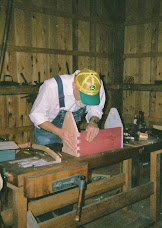
SANDING BLOCKS
I made the sanding blocks so they would fit my hand better than a block with 90 degree edges. The block in the back is a jumbo model. I just glued a 1/2" piece of wood to the top, before I used a wood rasp to make the "ergonomic" shapes.

Exploded View of Sanding Block

There are many sanding blocks on the market and I didn't like any of them, so I made my own.
Also, the time honored method of wraping a piece of sandpaper around a block of wood, although it does work, left a lot to be desired. When sanding a lot, my hand would cramp trying to hold the paper. This sanding block holds the paper tightly so you can concentrate on your work, plus it holds a 1/4 sheet at a time, saving you money. It is easy to fold and cut sandpaper into quarter sheets.
The threaded insert and the machine screw, allows the sanding block to be opened and closed over and over without losing it's grip on the sandpaper. I used two sizes of dowels so the top would always align itself perfectly with the bottom. It requires a little more work, but it is worth it. After making one, you probably will make another, so you can have a variety of sanding grits at your finger tips.
These materials are readily available at most hardware stores. Take your time and you will add a valuable tool to your wood shop!






















 SANDING BLOCKS
SANDING BLOCKS









